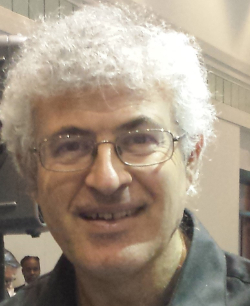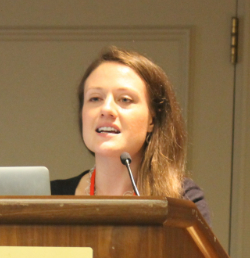
Photo credit: Peggy Toussant
At the ICSOM conference in Washington DC, Dr. Heather Malyuk, a full-time music audiologist, offered vital information about hearing damage and loss and the best ways to proactively avoid and/or treat them. She urged us to take care of our hearing with the same devotion that athletes keep themselves in shape, and to think of ourselves as “small muscle athletes”.
Trained as a violinist, she recalled how teachers offered her a vast array of ways to improve—an example was how to fully engage spinal muscles—but that none of them ever delved into how to conserve or protect one’s hearing. Fortunately, now musicians have a web-accessible resource available to help them do just that: “NASM/PAMA Advisories on Hearing Health.” Created by the National Association of Schools of Music and the Performing Arts Medicine Association, it is “a comprehensive overview of hearing health issues for postsecondary schools and departments of music.”

Dr. Heather Malyuk presenting at the conference
Photo credit: Dan Sweeley
Heather defined hearing loss as “a temporary or permanent blockage or permanent injury in the structures of the ear,” elaborating that most of the permanent injury occurs in the hair cells of the cochlea, each of which is tuned to a particular pitch like the keys of a piano. She alerted us that “sudden hearing loss” is caused by a viral infection, and must be treated with steroids within 48 hours in order to forestall the damage from becoming permanent. She also noted that smoking raises hearing loss risk by 15%.
Heather shared the powerful words of bassist Tal Wilkenfeld: “Sometimes I am shocked at how careless some musicians tend to be when it comes to protecting their ears, yet they’re so protective of their hands. Doesn’t make any sense to me. Music is all about listening.” (Note: quoted here.) She emphasized that musicians should get annual hearing checkups with an audiologist who is properly trained to assess musical hearing. Her organization, Sensaphonics Hearing Conservation, trains and provides a list of audiologists specially trained to assess musical hearing, with its much wider range and overtone spectrum (www.sensaphonics.com).
There are two national standards for evaluating safe exposure times for different sound levels: regulations issued by the Occupational Safety and Health Administration (OSHA); and the “Safe Exposure Guidelines” from the National Institute for Occupational Safety and Health (NIOSH), which is a research arm of the CDC. They are not identical, but they agree that sounds above the 85 dB threshold pose a potential threat to our hearing if exceeding the maximum recommended exposure times. Importantly, however, these standards refer to sustained sound at certain decibel levels—not the intermittent spikes of sound that we frequently encounter in the orchestral workplace.
Here are the recommended maximum exposure times for various decibel levels of sustained sound:
Safe Exposure Time (in hours)
| Level, in dBA | 85 | 88 | 90 | 91 | 94 | 95 | 97 | 100 | 105 | 110 | 115 |
| NIOSH | 8 | 4 | 2 | 1 | 0.5 | 0.25 | |||||
| OSHA | 16 | 8 | 4 | 3 | 2 | 1 | 0.5 | 0.25 |
Those thresholds can often be exceeded by orchestral instruments, as shown by the following:
Common Levels of Orchestral Instruments at Forte
| Instrument | Peak sound level (in dB) |
| Piano | 92-95 |
| Violin | 84-102 |
| Cello | 82-92 |
| Oboe | 90-94 |
| Flute | 85-111 |
| Piccolo | 95-112 |
| Clarinet | 92-103 |
| French Horn | 90-106 |
| Trombone | 85-114 |
| Timpani and bass drum rolls | 106 |
| Orchestral peaks | 120-137 |
In the midst of such high levels of sound in our workplace, an obvious first step to prevent hearing damage is the use of earplugs. Heather recommended that musicians find and purchase earplugs with the flattest frequency response. In this regard, she believes that filtered earplugs are much better than foam ones, as the former allow all frequencies through more or less equally and they are available in different filtering levels. High-quality electronic earplugs are also available that will amplify low-level sounds in addition to attenuating loud sounds.
In private correspondence with me while fact-checking this article, Heather also stressed the importance of verifying actual sound levels where one plays, and not simply relying on the general guidelines outlined above: “Checking decibel levels using a dosimeter is essential to know [the] risk of hearing injury. Sensaphonics created a device called dBCheck that can actually measure sound levels in the room or off of [In Ear Monitors (IEMs)] that will tell the musician how loud the room is/how loud he or she [is] listening through their IEMs. It will also show the musician in the two scales (OSHA and NIOSH) how many minutes of safety time he or she has before risking hearing injury. This piece of the puzzle is invaluable for any musician wanting to protect their hearing.”
In the case of hearing loss, she discussed two options: hearing aids (which she describes as “mini-PA systems”) and IEMs. Not having had experience with hearing aids, I was surprised to learn that they work primarily as a boost for hearing conversation, not music. The largest difference between music and speech is the much greater range of dynamics and pitch frequencies. Audiologists without special training to work with musicians do not test the full gamut of hearing. She stressed that hearing aids are programmable, and that musicians usually prefer “a more linear setting”, which results in a less compressed sound.
Heather cautioned about less than mindful use of IEMs. While such devices reduce background noise along with amplifying volume, they are not all of equal quality. Also, she believes it is a mistake to use them in a single ear only, as the utilizing ear compensates for the missing one by seeking a louder volume. She also described a new type of IEM, developed and patented by Sensaphonics, that she said can also be used by orchestral musicians as active earplugs to achieve much more flexibility and superior sound quality to standard filtered earplugs. For individuals with hearing loss, the system allows individual EQ levels to be adjusted to aesthetic taste, using a choice of devices such as a mixing board or smart phone. In 2014, musician and sound engineer Larry Revit published an article (“A Solution to Challenges Faced by Hearing-impaired Musicians Performing on Loud Amplified Stages”) in The Hearing Review describing his experience utilizing one of these devices to compensate for both-ear hearing loss.
The most important takeaway for me was that certain types of ear damage are undetectable except via testing; early detection and treatment can help the damage from worsening. The shocking revelation that most audiologists are not trained to work with musicians’ hearing wellness means that we must take extra care in protecting our most important musical asset. Based on this new awareness, I am now arranging to get my own hearing tested for the first time.





